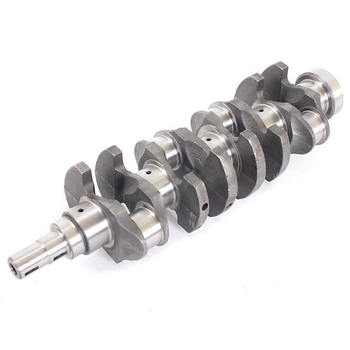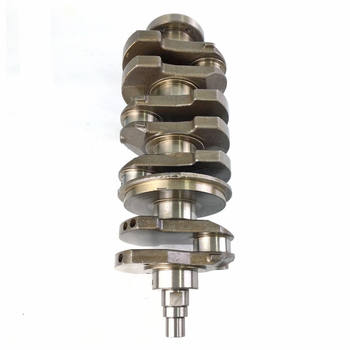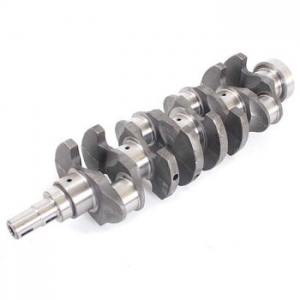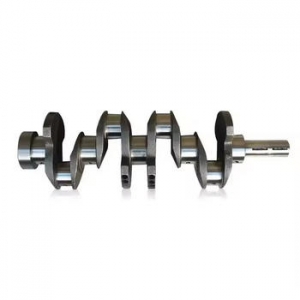Powering Giants: Unveiling the Critical Role of a Heavy Machinery Crankshaft Supplier
Views :
Update time : 2025-06-20
In the colossal realm of heavy machinery – think towering excavators, earth-shaking mining trucks, and mighty marine vessels – there are components so fundamental, yet often overlooked, that their failure can bring an entire operation to a grinding halt. Among these, the crankshaft stands supreme. It's the very heart of the engine, converting linear motion into rotational power. Frankly speaking, without a robust, perfectly engineered crankshaft, these mechanical titans are nothing more than static metal. This is precisely why the role of a top-tier heavy machinery crankshaft supplier is not just important, but absolutely critical to global infrastructure, mining, construction, and transportation.
Have you ever wondered about the immense forces at play within a massive diesel engine? The crankshaft endures incredible torsional stress, bending moments, and fatigue loads, day in and day out. Its design, material, and manufacturing precision directly dictate the engine's performance, longevity, and reliability. Therefore, selecting the right partner for these vital components isn't merely a purchasing decision; it's a strategic investment in operational uptime and overall project success.
Why the Crankshaft is the Heartbeat of Heavy Machinery
To be honest, the crankshaft is more than just a component; it's the very pulse of any internal combustion engine, especially those powering heavy machinery. Its primary function is to convert the reciprocating motion of the pistons into rotational motion, which then drives the wheels, tracks, or propellers of the machinery. Imagine the sheer power needed to move tons of earth, lift immense loads, or propel a massive ship across oceans. All this power originates from the controlled explosions within the engine's cylinders, transferred directly through the connecting rods to the crankshaft. The demands placed on crankshafts in heavy machinery are extraordinary. They must withstand immense pressures from combustion, extreme temperatures, and constant vibrational stress. A crankshaft in a mining truck, for instance, might operate continuously for thousands of hours under full load, enduring millions of stress cycles. This isn't just about moving; it's about enduring. This is why the metallurgy, forging, machining, and balancing of these components must be executed with absolute perfection. From construction equipment like bulldozers and cranes to agricultural tractors and industrial generators, the crankshaft is the linchpin. Its integrity directly impacts fuel efficiency, power output, and, most importantly, the safety and operational lifespan of the entire machine.What Defines a Top-Tier Heavy Machinery Crankshaft Supplier?
When you're dealing with components that are literally the backbone of multi-million dollar machines, "good enough" simply doesn't cut it. A truly exceptional heavy machinery crankshaft supplier distinguishes itself through several key attributes, all centered around uncompromising quality and engineering prowess.Material Science and Engineering Excellence
The foundation of any high-performance crankshaft lies in its material. Top suppliers understand that this isn't a place to cut corners. They typically utilize high-grade forged steel alloys, such as 42CrMo4, 34CrNiMo6, or specialized ductile irons, chosen for their superior tensile strength, fatigue resistance, and toughness. The process of forging, which involves shaping the metal under immense pressure and heat, aligns the grain structure, significantly enhancing the material's strength and durability compared to casting. Interestingly enough, the precise chemical composition and heat treatment processes are proprietary secrets for many leading manufacturers, fine-tuned over decades to achieve optimal performance characteristics for specific applications.Advanced Manufacturing Processes
Beyond the raw material, the manufacturing process itself is a symphony of precision. A leading heavy machinery crankshaft supplier employs state-of-the-art machinery and techniques. This includes: * Precision Machining: Utilizing advanced CNC (Computer Numerical Control) machines to achieve incredibly tight tolerances for critical dimensions like journal diameters, crankpin positions, and counterweight shapes. * Heat Treatment: Processes like induction hardening or nitriding are applied to the bearing surfaces to increase their hardness and wear resistance, extending the crankshaft's operational life. * Balancing: Dynamic balancing is crucial. Even a slight imbalance can lead to excessive vibrations, premature bearing wear, and catastrophic engine failure. Sophisticated balancing machines ensure the crankshaft rotates smoothly at high RPMs. * Surface Finishing: Grinding and polishing techniques are used to achieve extremely smooth surface finishes on journals, reducing friction and wear on bearings. In my experience, it's the meticulous attention to these details, combined with continuous innovation in manufacturing techniques, that separates the industry leaders from the rest.Customization and Adaptability
Heavy machinery is incredibly diverse, with engines varying widely in size, power output, and specific application requirements. A truly versatile heavy machinery crankshaft supplier offers not just standard catalog items but also possesses the engineering capability for customization. This might involve: * Bespoke Designs: Working with clients to design and manufacture crankshafts for unique engine configurations or specialized equipment. * Reverse Engineering: The ability to accurately reverse engineer existing crankshafts for replacement parts, especially for older or discontinued machinery where original parts are no longer available. * Prototyping: Developing and testing prototypes for new engine designs or performance upgrades. This adaptability ensures that clients can always find a solution, no matter how niche their requirements might be.The Rigorous Journey: From Raw Material to Ready-to-Install Crankshaft
The creation of a heavy machinery crankshaft is a complex, multi-stage process that demands precision at every turn. It's a journey that transforms raw metal into a highly engineered component capable of withstanding immense forces. The process typically begins with the careful selection of high-grade steel ingots or billets. These are then heated to extreme temperatures, often exceeding 1,200°C (2,200°F), before being subjected to the forging process. This is where massive hydraulic presses or hammers shape the glowing metal into a rough crankshaft form, aligning the grain structure and enhancing its strength. For very large crankshafts, open-die forging might be used, while smaller ones might go through closed-die forging.
Choosing the Right Partner: Key Considerations When Selecting a Heavy Machinery Crankshaft Supplier
Selecting a heavy machinery crankshaft supplier is a decision that can significantly impact your operational efficiency and bottom line. It's not just about price; it's about long-term value, reliability, and partnership.Reputation and Experience
Look for suppliers with a proven track record in the industry. How long have they been in business? What is their reputation for quality and delivery? Client testimonials, case studies, and industry references can provide valuable insights. A supplier with decades of experience in industrial engine crankshaft manufacturing likely possesses the accumulated knowledge and expertise to handle complex requirements.Quality Assurance and Certifications
Insist on suppliers who adhere to stringent quality management systems, such as ISO 9001. Look for specific industry certifications relevant to heavy machinery components. Ask about their internal quality control processes, testing methodologies, and traceability of materials. A commitment to quality is non-negotiable when it comes to such critical parts.Technical Support and After-Sales Service
A good supplier doesn't just sell you a product and disappear. They offer robust technical support, assisting with specifications, troubleshooting, and installation guidance. What kind of warranty do they offer? How responsive are they to inquiries or potential issues? Reliable after-sales service is a hallmark of a customer-centric partner.Supply Chain Reliability and Logistics
Timely delivery is paramount, especially when machinery downtime is costly. Evaluate the supplier's production capacity, lead times, and logistical capabilities. Do they have a global distribution network if you operate internationally? A supplier capable of providing reliable crankshaft parts for construction and other industries consistently and on schedule is invaluable.
The Future of Crankshaft Manufacturing: Innovations and Trends
The world of heavy machinery is constantly evolving, and so too is the manufacturing of its core components. The future of crankshaft production is being shaped by several exciting trends aimed at improving performance, efficiency, and sustainability. One significant area of focus is advanced materials. Researchers are exploring new alloys that offer even greater strength-to-weight ratios, allowing for lighter yet more durable crankshafts. This can lead to improved fuel efficiency and reduced emissions in heavy equipment. Composites and hybrid materials are also being investigated for specialized applications, though steel remains dominant for its proven robustness. Additive manufacturing, or 3D printing, is beginning to play a role, particularly in prototyping and the production of highly specialized or complex crankshaft designs for niche applications. While not yet scalable for mass production of large heavy machinery crankshafts, it holds promise for rapid development and customization. Furthermore, the integration of Industry 4.0 technologies, such as IoT (Internet of Things) sensors and AI-driven analytics, is making manufacturing processes smarter. Real-time monitoring of production lines can optimize efficiency, predict maintenance needs for machinery, and ensure even higher levels of quality control. This means a modern heavy machinery crankshaft supplier is increasingly leveraging data to refine their processes. Sustainability is another growing concern. Manufacturers are looking into more energy-efficient production methods, reducing waste, and exploring ways to recycle materials more effectively. The goal is to produce high-performance components with a smaller environmental footprint. I've found that the most forward-thinking suppliers are already investing heavily in these areas, ensuring they remain at the forefront of innovation.Conclusion: Powering Progress with the Right Heavy Machinery Crankshaft Supplier
In the demanding world of heavy machinery, where uptime is king and reliability is paramount, the crankshaft stands as a testament to precision engineering and material science. It is the component that translates raw power into productive motion, enabling the construction of our infrastructure, the extraction of vital resources, and the movement of goods across the globe. Choosing the right heavy machinery crankshaft supplier is not a decision to be taken lightly. It requires a thorough evaluation of their expertise, manufacturing capabilities, commitment to quality, and dedication to customer service. A truly exceptional supplier acts as a strategic partner, providing not just parts, but solutions that contribute directly to the longevity, efficiency, and performance of your most critical assets. By investing in high-quality crankshafts from a reputable source, you are investing in the uninterrupted progress of your operations and the enduring power of your machinery.For more detailed information, please visit our official website:heavy machinery crankshaft supplier
About the author: Dr. Alistair Finch is a veteran mechanical engineer with over 25 years of experience specializing in heavy industrial components and powertrain systems. His expertise spans material science, advanced manufacturing, and quality assurance for critical machinery parts. He frequently consults for leading global manufacturers, offering insights into optimizing performance and reliability in demanding applications.
Related News
Read More >>
 Powering Giants: Unveiling the
Powering Giants: Unveiling the
06 .20.2025
Discover the vital role of a heavy machinery crankshaft supplier. Learn what defines excellence in t...
 Unlocking Power: The Essential
Unlocking Power: The Essential
06 .20.2025
Discover why a custom industrial crankshaft manufacturer is crucial for specialized power needs, ens...
 Unlocking Power: A Deep Dive i
Unlocking Power: A Deep Dive i
06 .20.2025
Explore critical heavy duty crankshaft material properties, from forged steel to ductile iron, and h...
 Forged vs. Billet Crankshafts:
Forged vs. Billet Crankshafts:
06 .20.2025
Explore the critical differences between forged and billet crankshafts for industrial use. Understan...
